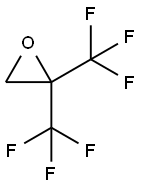Epifluorohydrin
Synonym(s):1,2-Epoxy-3-fluoropropane
- CAS NO.:503-09-3
- Empirical Formula: C3H5FO
- Molecular Weight: 76.07
- MDL number: MFCD00005131
- EINECS: 207-960-1
- SAFETY DATA SHEET (SDS)
- Update Date: 2024-12-18 14:15:32

What is Epifluorohydrin?
Chemical properties
clear colourless liquid
The Uses of Epifluorohydrin
Epifluorohydrin is used as a reagent in the synthesis of N-arylphosphoramidates. In addition, it is used in the synthesis of orally bioavailable ALK inhibitors in the treatment of tumors.
General Description
Clear colorless liquid.
Air & Water Reactions
Highly flammable. Water soluble.
Reactivity Profile
A halogenated epoxide. Epoxides are highly reactive. They polymerize in the presence of catalysts or when heated. These polymerization reactions can be violent. Compounds in this group react with acids, bases, and oxidizing and reducing agents. They react, possibly violently with water in the presence of acid and other catalysts. The chlorinated derivative has been shown to be incompatible with aniline, strong oxidizers, sulfuric acid, isopropylamine, zinc, aluminum, iron, etc. see epichlorohydrin.
Health Hazard
ACUTE/CHRONIC HAZARDS: Epifluorohydrin is a lacrimator. When heated to decomposition it emits toxic fumes.
Fire Hazard
Epifluorohydrin is flammable.
Properties of Epifluorohydrin
| Boiling point: | 85-86 °C (lit.) |
| Density | 1.067 g/mL at 25 °C (lit.) |
| refractive index | n |
| Flash point: | 40 °F |
| storage temp. | 0-6°C |
| color | clear |
| CAS DataBase Reference | 503-09-3(CAS DataBase Reference) |
| NIST Chemistry Reference | Oxirane, (fluoromethyl)-(503-09-3) |
| EPA Substance Registry System | Epifluorohydrin (503-09-3) |
Safety information for Epifluorohydrin
| Signal word | Danger |
| Pictogram(s) |
 Flame Flammables GHS02  Corrosion Corrosives GHS05  Skull and Crossbones Acute Toxicity GHS06 |
| GHS Hazard Statements |
H225:Flammable liquids H314:Skin corrosion/irritation |
| Precautionary Statement Codes |
P210:Keep away from heat/sparks/open flames/hot surfaces. — No smoking. P233:Keep container tightly closed. P280:Wear protective gloves/protective clothing/eye protection/face protection. P303+P361+P353:IF ON SKIN (or hair): Remove/Take off Immediately all contaminated clothing. Rinse SKIN with water/shower. P305+P351+P338:IF IN EYES: Rinse cautiously with water for several minutes. Remove contact lenses, if present and easy to do. Continuerinsing. |
Computed Descriptors for Epifluorohydrin
New Products
4-Fluorophenylacetic acid 4-Methylphenylacetic acid N-Boc-D-alaninol N-BOC-D/L-ALANINOL Tert-butyl bis(2-chloroethyl)carbamate 3-Morpholino-1-(4-nitrophenyl)-5,6-dihydropyridin- 2(1H)-one Furan-2,5-Dicarboxylic Acid Tropic acid S-2-CHLORO PROPIONIC ACID ETHYL ISOCYANOACETATE 2-Bromo-1,3-Bis(Dimethylamino)Trimethinium Hexafluorophosphate (6-METHYL-[1,3]DITHIOLO[4,5-b]QUINOXALIN-2-ONE INDAZOLE-3-CARBOXYLIC ACID 4-IODO BENZOIC ACID (2-Hydroxyphenyl)acetonitrile 4-Bromopyrazole 5,6-Dimethoxyindanone 2-(Cyanocyclohexyl)acetic acid 4-methoxy-3,5-dinitropyridine 2-aminopropyl benzoate hydrochloride 1-(4-(aminomethyl)benzyl)urea hydrochloride diethyl 2-(2-((tertbutoxycarbonyl)amino) ethyl)malonate tert-butyl 4- (ureidomethyl)benzylcarbamate Ethyl-2-chloro((4-methoxyphenyl)hydrazono)acetateRelated products of tetrahydrofuran








You may like
-
 Epifluorohydrin CAS 503-09-3View Details
Epifluorohydrin CAS 503-09-3View Details
503-09-3 -
 2033-24-1 98%View Details
2033-24-1 98%View Details
2033-24-1 -
 1975-50-4 98%View Details
1975-50-4 98%View Details
1975-50-4 -
 2-HYDROXY BENZYL ALCOHOL 98%View Details
2-HYDROXY BENZYL ALCOHOL 98%View Details
90-01-7 -
 2-Chloro-1,3-Bis(Dimethylamino)Trimethinium Hexafluorophosphate 221615-75-4 98%View Details
2-Chloro-1,3-Bis(Dimethylamino)Trimethinium Hexafluorophosphate 221615-75-4 98%View Details
221615-75-4 -
 61397-56-6 CIS BROMO BENZOATE 98%View Details
61397-56-6 CIS BROMO BENZOATE 98%View Details
61397-56-6 -
 14714-50-2 (2-Hydroxyphenyl)acetonitrile 98+View Details
14714-50-2 (2-Hydroxyphenyl)acetonitrile 98+View Details
14714-50-2 -
 118753-70-1 98+View Details
118753-70-1 98+View Details
118753-70-1